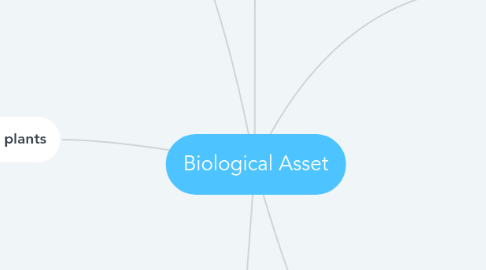
1. Key Terms
1.1. Agricultural activities
1.1.1. management by an entity of the biological transformation
1.1.2. harvest of biological assets for
1.1.2.1. sale
1.1.2.2. conversion into agricultural produce
1.1.2.3. into additional biological assets
1.1.3. Common features
1.1.3.1. Capability to change
1.1.3.1.1. Living animals and plants are capable of biological transformation
1.1.3.2. Management of change
1.1.3.2.1. Management facilitates biological transformation by enhancing,
1.1.3.2.2. or at least stabilizing, conditions necessary for the process to take place (like nutrient levels, moisture, temperature, fertility and light).
1.1.3.2.3. Such management distinguishes agricultural activity from other activities.
1.1.3.2.4. For example, harvesting from unmanaged sources (e.g. ocean fishing) is not agricultural activity.
1.1.3.3. Measurement of change
1.1.3.3.1. The change in quality (e.g. genetic merit, ripeness, and fibre strength)
1.1.3.3.2. or quantity (e.g. progeny, weight, fibre length and number of buds)
1.1.3.3.3. brought about by biological transformation or harvest
1.1.3.3.4. is measured and monitored as a routine management function.
1.2. Biological transformation
1.2.1. processes of growth, degeneration, production, and procreation
1.2.2. that cause qualitative or quantitative changes in a biological asset.
1.3. Agriculture produce
1.3.1. harvested produce of the entity’s biological assets.
1.4. Harvest
1.4.1. detachment of produce from a biological asset or the cessation of a biological asset’s life processes
2. Bearer plants
2.1. plants that bear the produce which would then be harvested
2.2. would continue to bear the produce until they are no longer productive
2.3. Some bearer plants are within the scope of MFRS 116 – Property, Plant and Equipment
2.4. Issue
2.4.1. whether they fall in the scope of MFRS 141 – Agriculture.
2.4.2. Amendments were made to MFRS 116 and 141 which introduces the definition of a bearer plant.
2.4.3. Plants that meet the definition of a bearer plant would be accounted for in accordance with MFRS 116 – Property, Plant and Equipment,
2.4.3.1. Either cost model
2.4.3.2. Or revaluation model
3. Recognition
3.1. (MFRS 141) Conditions to be met
3.1.1. The entity controls the assets as a result of past events
3.1.2. It is probable that future economic benefit associated with the asset will flow to the entity
3.1.3. The fair value or cost of the asset can be measured reliably
3.2. Control in the agricultural activity
3.2.1. may be evidenced by legal ownership of the assets
3.2.1.1. i.e. the ability to sell or pledge the assets
3.2.2. the exposure of risks and rewards of ownership of the assets
3.2.2.1. in the case of leases
3.2.3. Examples
3.2.3.1. legal ownership of cattle and the branding or marking of the cattle on acquisition, birth or weaning.
4. MFRS114 Biological Assets
4.1. Biological asset is a living animal or plant.
4.2. except
4.2.1. bearer plants
4.2.2. agricultural produce at the point of harvest
4.2.3. government grants that relates to agricultural activity
4.3. does not apply to land or intangible assets related to agricultural activity.
5. Measurement
5.1. Biological asset
5.1.1. Initial recognition
5.1.1.1. at its fair value less cost to sell when the fair value can be measured reliably.
5.1.1.2. Journal entry:
5.1.1.2.1. Dr Biological asset Cr Cash (To record acquisition of the ___)
5.1.2. Subsequent measurement at the end of each reporting period
5.1.2.1. at its fair value less cost to sell when the fair value can be measured reliably.
5.1.2.2. Journal entry
5.1.2.2.1. Dr Biological asset Cr Profit or loss (To recognise the ___ at fair value)
5.2. Agriculture produce harvested from an entity’s biological asset
5.2.1. fair value less costs to sell at the point of harvest .
5.3. Fair value
5.3.1. the amount for which the asset could be exchanged between knowledgeable, willing parties in an arm’s length transaction.
5.3.2. has to be based on its present location and condition
5.3.3. group biological assets or agricultural produce according to their significant attributes
5.3.3.1. Age
5.3.3.2. Quality
5.3.3.3. The selection of attributes are corresponding to the attributes used in the market for basis of pricing
5.3.4. Argument
5.3.4.1. fair value are less reliable measurement for biological assets
5.3.4.2. Nevertheless IASB believes that fair value is the best measurement
5.3.4.2.1. because the changes in biological assets have direct relationship to changes in expectations of future economic benefits.
6. Disclosure
6.1. The aggregate gain or loss that arise during the current period on initial recognition of biological asset and agricultural produce.
6.2. A description of each group of biological assets.
6.3. The nature of activities involving each group of biological assets period.
6.4. Non-financial measures or estimates of the physical quantities of
6.4.1. (i) each group biological assets at the end of the period
6.4.2. (ii) output of agriculture produce during the period.
6.5. The methods and significant assumptions used in determining the fair value of each group of biological assets and agricultural produce at the point of harvest.
6.6. The fair value less costs to sell of agricultural produce at the point of harvest.
6.7. The existence and carrying amount of biological assets whose title is restricted, and the carrying amount of biological assets pledged as security for liabilities.
6.8. The amount of commitments for the development or acquisition of biological assets.
6.9. Financial risk management strategies related to agricultural activity.
6.10. A reconciliation of changes in the carrying amount of biological assets between the beginning and the end of the current period.
6.11. Fair value cannot be measured reliably
6.11.1. A description of the biological assets.
6.11.2. An explanation of why fair value cannot be measured reliably.
6.11.3. The range of estimates within which fair value is highly likely to lie (if possible).
6.11.4. The depreciation method used.
6.11.5. The useful lives or depreciation rates used.
6.11.6. The gross carrying amount and the accumulated depreciation (aggregated with accumulated impairment losses) at the beginning and end of the period.

